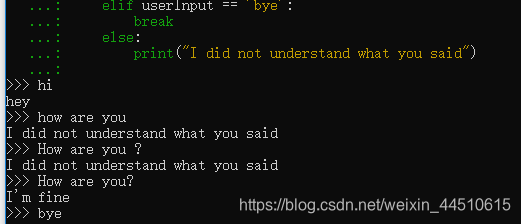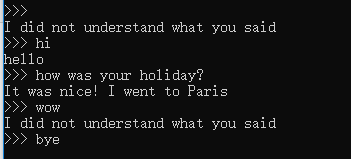
本文共 4350 字,大约阅读时间需要 14 分钟。
rule 规则
最基础版本的rule-base机器人
import random# 打招呼greetings = ['hola', 'hello', 'hi', 'Hi', 'hey!','hey']# 回复打招呼random_greeting = random.choice(greetings)# 对于“你怎么样?”这个问题的回复question = ['How are you?','How are you doing?']# “我很好”responses = ['Okay',"I'm fine"]# 随机选一个回random_response = random.choice(responses)# 机器人跑起来while True: userInput = input(">>> ") if userInput in greetings: print(random_greeting) elif userInput in question: print(random_response) # 除非你说“拜拜” elif userInput == 'bye': break else: print("I did not understand what you said") 
显然 这样的rule太弱智了,我们需要更好一点的“精准对答”
比如
透过关键词来判断这句话的意图是什么(intents)

from nltk import word_tokenizeimport random# 打招呼greetings = ['hola', 'hello', 'hi', 'Hi', 'hey!','hey']# 回复打招呼random_greeting = random.choice(greetings)# 对于“假期”的话题关键词question = ['break','holiday','vacation','weekend']# 回复假期话题responses = ['It was nice! I went to Paris',"Sadly, I just stayed at home"]# 随机选一个回random_response = random.choice(responses)# 机器人跑起来while True: userInput = input(">>> ") # 清理一下输入,看看都有哪些词 cleaned_input = word_tokenize(userInput) # 这里,我们比较一下关键词,确定他属于哪个问题 if not set(cleaned_input).isdisjoint(greetings): print(random_greeting) elif not set(cleaned_input).isdisjoint(question): print(random_response) # 除非你说“拜拜” elif userInput == 'bye': break else: print("I did not understand what you said") 
现在主流的研究方向,是做到语义层面的对应。
比如,“肚子好饿哦”, “饭点到了”
都应该表示的是要吃饭了的意思。
在这个层面,就需要用到word vector之类的embedding方法,
光是会BB还是不行,得有知识体系!才能解决用户的问题。
我们可以用各种数据库,建立起一套体系,然后通过搜索的方式,来查找答案。
比如,最简单的就是Python自己的graph数据结构来搭建一个“地图”。
依据这个地图,我们可以清楚的找寻从一个地方到另一个地方的路径,
然后作为回答,反馈给用户。
# 建立一个基于目标行业的database# 比如 这里我们用python自带的graphgraph = {'上海': ['苏州', '常州'], '苏州': ['常州', '镇江'], '常州': ['镇江'], '镇江': ['常州'], '盐城': ['南通'], '南通': ['常州']}# 明确如何找到从A到B的路径def find_path(start, end, path=[]): path = path + [start] if start == end: return path if start not in graph: return None for node in graph[start]: if node not in path: newpath = find_path(node, end, path) if newpath: return newpath return None print(find_path('上海', "镇江")) [‘上海’, ‘苏州’, ‘常州’, ‘镇江’]
任何行业,都分个前端后端。
AI也不例外。
我们这里讲的算法,都是后端跑的。
那么, 为了做一个靠谱的前端,很多项目往往也需要一个简单易用,靠谱的前端。
比如,这里,利用Google的API,写一个类似钢铁侠Tony的语音小秘书Jarvis:
我们先来看一个最简单的说话版本。
利用gTTs(Google Text-to-Speech API), 把文本转化为音频。
使用gTTS,必须要科学上网(访问外网才行)
from gtts import gTTSimport ostts = gTTS(text='您好,我是您的私人助手,我叫小辣椒', lang='zh-tw')tts.save("hello.mp3")os.system("mpg321 hello.mp3") 有了文本到语音的功能,
我们还可以运用Google API读出Jarvis的回复:
(注意:这里需要你的机器安装几个库 SpeechRecognition, PyAudio 和 PySpeech)
import speech_recognition as srfrom time import ctimeimport timeimport osfrom gtts import gTTSimport sys # 讲出来AI的话def speak(audioString): print(audioString) tts = gTTS(text=audioString, lang='en') tts.save("audio.mp3") os.system("mpg321 audio.mp3")# 录下来你讲的话def recordAudio(): # 用麦克风记录下你的话 r = sr.Recognizer() with sr.Microphone() as source: audio = r.listen(source) # 用Google API转化音频 data = "" try: data = r.recognize_google(audio) print("You said: " + data) except sr.UnknownValueError: print("Google Speech Recognition could not understand audio") except sr.RequestError as e: print("Could not request results from Google Speech Recognition service; {0}".format(e)) return data# 自带的对话技能(rules)def jarvis(): while True: data = recordAudio() if "how are you" in data: speak("I am fine") if "what time is it" in data: speak(ctime()) if "where is" in data: data = data.split(" ") location = data[2] speak("Hold on Tony, I will show you where " + location + " is.") os.system("open -a Safari https://www.google.com/maps/place/" + location + "/&") if "bye" in data: speak("bye bye") break# 初始化time.sleep(2)speak("Hi Tony, what can I do for you?")# 跑起jarvis() Hi Tony, what can I do for you?
You said: how are you I am fine You said: what time is it now Fri Apr 7 18:16:54 2017 You said: where is London Hold on Tony, I will show you where London is. You said: ok bye bye bye bye 不仅仅是语音前端。包括应用场景:微信,slack,Facebook Messager,等等 都可以把我们的ChatBot给integrate进去。
转载地址:https://maoli.blog.csdn.net/article/details/91882618 如侵犯您的版权,请留言回复原文章的地址,我们会给您删除此文章,给您带来不便请您谅解!
发表评论
最新留言
关于作者
